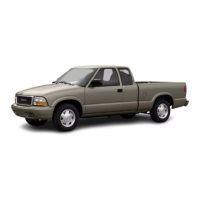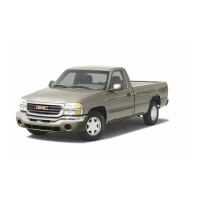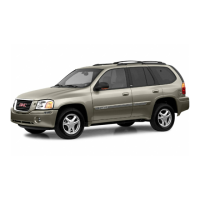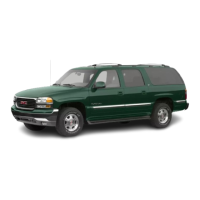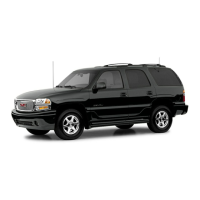
Do you have a question about the GMC 2003 Safari and is the answer not in the manual?
| Brand | GMC |
|---|---|
| Model | 2003 Safari |
| Category | Automobile |
| Language | English |
Details manual and power seat adjustments, including lumbar support and reclining features.
Covers rear seat operation, including bench and bucket seat adjustments.
Explains proper safety belt usage, including for pregnant women and different seating positions.
Provides guidance on using safety belts for older children and infants, and child restraint systems.
Explains air bag function, inflation, and servicing for air bag-equipped vehicles.
Guides on checking restraint systems and replacing parts after a crash.
Information about vehicle keys, including the single double-sided key and bar-coded tag.
Details on locking/unlocking doors, power door locks, and programmable automatic door lock features.
Covers manual and power windows, including express-down feature and sun visors.
Explains the Passlock system designed to prevent vehicle theft.
Guidance on new vehicle break-in, ignition positions, and starting the engine.
Describes manual rearview, outside manual, outside power, and outside convex mirrors.
Details front and rear storage compartments, including the overhead console and glove box.
Information on the HomeLink transmitter for activating devices like garage door openers.
Allows switching the display between English and metric units.
Toggles between OFF, COMP/TEMP, and TRIP display modes.
Displays outside temperature and compass direction.
Shows trip functions like average economy, range, and average speed.
Identifies main components of the instrument panel with labeled diagrams.
Explains the function and location of the hazard warning flasher button.
Discusses the use of reflective triangles for warning others.
Instructions on how to sound the vehicle's horn.
Details on adjusting the steering wheel for driving comfort and entry/exit.
Explains the functions of the turn signal and multifunction lever.
Describes the operation of exterior lamp controls, including automatic headlamps.
Covers instrument panel brightness, exit lighting, and entry lighting features.
Details how to control heating, cooling, and ventilation using the system's knobs and modes.
Explains the purpose and function of various warning lights and gauges.
Provides an overview of the vehicle's instrument panel gauges and indicators.
Explains how to read vehicle speed and track distance driven.
Details how to use and reset the trip odometer.
Describes the function of the safety belt reminder light and tone.
Explains the air bag readiness light and its meaning.
Indicates potential issues with the vehicle's charging system.
Shows the battery's state of charge and the charging system's condition.
Alerts to potential problems with the vehicle's hydraulic brake system.
Indicates issues with the anti-lock braking system.
Displays engine coolant temperature; indicates overheating if in the red area.
Warns of issues with the engine, fuel, or emission control systems.
Shows engine oil pressure; low pressure may indicate a serious problem.
Indicates the status of the theft-deterrent system.
Alerts to potential problems with the drive system.
Indicates when the tow/haul mode has been selected.
Reminds to check coolant temperature and oil pressure gauges.
Indicates the approximate amount of fuel remaining in the tank.
Illuminates when the fuel tank is low on fuel.
Guides on operating the vehicle's audio system, including radio and CD functions.
Explains the radio's theft-deterrent feature and its activation/deactivation.
General advice on driving safely and maintaining vehicle control.
Emphasizes anticipating hazards and avoiding distractions while driving.
Highlights the dangers of alcohol impairment and its effects on driving.
Explains the three systems that control vehicle movement: brakes, steering, and accelerator.
Details braking action, perception and reaction times, and stopping distances.
Covers power steering, steering tips, and driving on curves.
Provides tips for safely passing other vehicles on two-lane highways.
Discusses what happens when control systems lack friction, focusing on skidding.
Offers tips for safer night driving, including visibility and hazard awareness.
Advises on safe driving practices in rain, including tire condition and visibility.
Explains hydroplaning, its causes, and the importance of slowing down in rain.
Offers ways to increase safety in city driving, focusing on traffic and signals.
Provides rules and advice for safe freeway driving, including merging and lane usage.
Checklists and advice for ensuring the vehicle and driver are ready for long trips.
Tips for safer driving on steep hills and mountain roads, including brake and engine use.
Provides tips for winter driving, including vehicle preparation and emergency supplies.
Guidance on how to free a stuck vehicle safely, including the 'rocking' method.
Covers general towing information, including vehicle preparation and types of towing.
Advice for safely handling a vehicle while towing a trailer.
Guidance on performing service work, using GM parts, and dealer recommendations.
Information on gasoline octane, specifications, additives, and filling the fuel tank.
Covers engine oil, coolant, overheating, fan noise, power steering, and windshield washer fluid.
Details on brake fluid, wear, adjustment, replacement parts, and battery.
Includes tire pressure, inspection, rotation, replacement, and changing a flat tire.
Guides on cleaning the vehicle interior and exterior, including fabric, vinyl, leather, and metal parts.
Information on Vehicle Identification Number (VIN) and Service Parts Identification Label.
Covers add-on electrical equipment, headlamp wiring, fuses, and circuit breakers.
Lists fluid capacities, engine specifications, and tire pressures for maintenance.
Provides part numbers for common maintenance items like filters, plugs, and wiper blades.
Overview of the maintenance schedule, including introduction and requirements.
Explains the structure of the maintenance schedule section.
Details scheduled maintenance services and their intervals.
Helps determine whether to follow the short trip/city or long trip/highway schedule.
Lists owner checks and services to be performed at specific intervals.
Outlines periodic inspections recommended for dealer or service center performance.
Lists recommended fluids and lubricants for vehicle maintenance.
Provides a log for recording vehicle maintenance dates and services performed.
General overview of customer assistance and satisfaction procedures.
Steps to resolve concerns with dealers and GMC customer relations.
Information about the MyGMLink Owner Center for vehicle information and service.
Contact information for TTY users needing customer assistance.
Contact details for GMC Customer Assistance Centers in various regions.
Details on the program to reimburse adaptive equipment costs for disabled individuals.
Information on GMC's roadside assistance services for stranded owners.
Explains dealer-provided transportation options during warranty repairs.
How to report vehicle safety defects to NHTSA.
How to report vehicle safety defects to Transport Canada.
Information on how to order service manuals and other publications.



